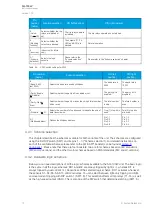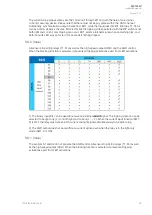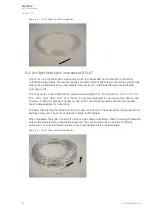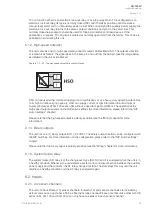
LED
name
(color)
Off
Steady light
Blinking
Action if abnormal
S1–S4,
S6–S15
(amber)
Normal
status.
Light information has activated
the sensor channel.
There is a sensor channel
discontinuity, or a system
setup has not been
performed; or
or, pressure
information has activated the
sensor channel.
Check sensor continuity or
perform a system setup (see
the "System setup (auto-
configuration)" chapter); or
or,
check what activated the
sensor.
S5
(amber)
((op
optional)
tional)
Normal
status.
The fiber sensor channel has
been activated. Or
Or, if the unit
has AQD control configured to
this sensor channel, an arc
flash has activated the channel.
There is a fiber sensor
discontinuity, or a system
setup has not been
performed.
Check sensor continuity or
perform a system setup (see
the "System setup (auto-
configuration)" chapter); or
or,
check what activated the
sensor.
BI1–BI2
(amber)
Normal
status.
The binary input has been
activated.
The binary input has a loose
connection.
Check the binary input wiring.
BO1
(amber)
Normal
status.
The binary outpus has been
activated.
N/A
-
HSO
(red)
Normal
status.
The high-speed output has
been activated.
N/A
Check the activated output,
clear the fault, and reset the
indicator LEDs with the push-
button.
4.3. Push-button (SET)
The unit contains one push-button, SET
SET, and it can be used for all operational functions. The push-
button is used for setting up the system (also known as auto-configuration), for resetting the indicator
LEDs and the latched output relays, as well as for checking the input connection.
4.3.1. System setup (auto-configuration)
After all sensors and binary lines have been connected, a system setup procedure (also known as
auto-configuration) must be performed. The sequence is initialized by pressing the SET
SET push-button for
two seconds. This causes the sensor and binary LEDs to start blinking. The unit scans these inputs to
see if they are connected; when an input is detected, the corresponding LED lights up to mark that a
connection was found. All inputs that are not connected continue to blink for three more seconds.
Then, all LEDs are turned off. Additionally, the DIP switch setting are stored in the non-volatile memory
during this sequence.
All sensor inputs remain operational even when they have not been auto-configured. System setup is
only used for self-supervision purposes.
Please note that to reconfigure a unit with fewer connections (BI/BO or sensors) than in the previously
memorized setup, one of the DIP switches must be moved back and forth once before the system
setup procedure is carried out. After this, you must wait one minute before you begin the new auto-
configuration sequence.
You can reconfigure a unit with more connections at any time without the wait and without having to
move one of the DIP switches.
4.3.2. Reset
All LED indications and latched trip relays can be reset by pressing the SET
SET push-button for
one second.
A
AQ
Q-103L
-103LV
V
Instruction manual
Version: 1.00
17
© Arcteq Relays Ltd




































